KWALE EYE
CENTER (
For
many years
now we are spending our winter holidays in
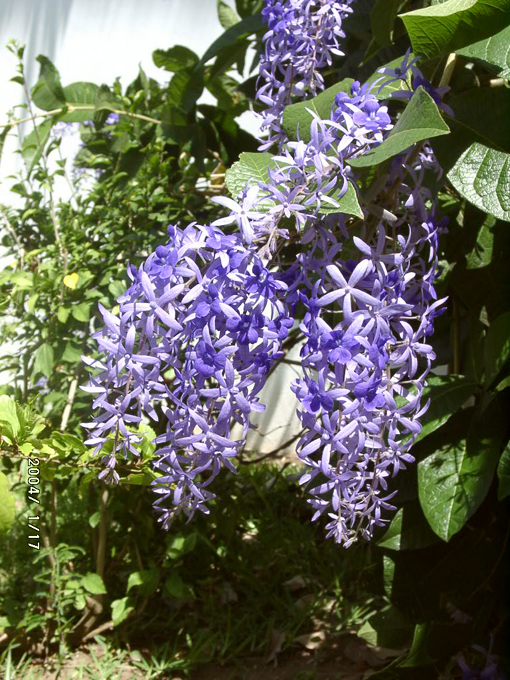
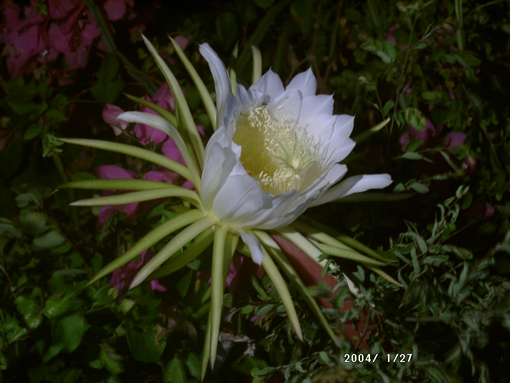
At left PURPLE WREATH bush and QUEEN OF NIGHT for 1 night at right
Pictures from Leisure Lodge Resort gardens
The
almost
straight road passes between patches of forest and palms woods as well
as a few
scattered settlements. There are some police blocks along the road and
any vehicle
has to slow down slaloming between boards holding long spikes on.
About
halfway there
is a right turn for a road leading to Kwale a larger settlement that is
located at
the foot of Shimba Hills Reserve about 3km
far only.
A while later another narrow earthen road at left leads toward the Kwale District
Eye Center about that I would like to report later.
Since
several
years Ljiljana collects summer dresses, shirts and underwear for
grownups and
children as well as school utensils and toys. As members of the LTU
Charter
Carrier we are entitled to 30kg luggage each and Ljiljana uses her part
mostly
for her “collection”. She has a long list with names of Resort’s lower
level
staff members including the number and age of their children too. Once
we have
settled in our room Ljiljana sorts the goodies by placing the selected
pieces to plastic
bags
each with a paper slip listing the items that she would sign adding
recipient’s
name later. The signed list has to be produced at Resort's checkpoint
when a recipient leaves it with any parcel. Although the staff changes
from year to year
there are
still many who know Ljiljana well from our several visits. They are
waiting for Ljiljana’s to
open her “boutique” to start handing out goodies in bags with the list
of items and
receiver’s
name. The staff members like to talk to her in Swahili (
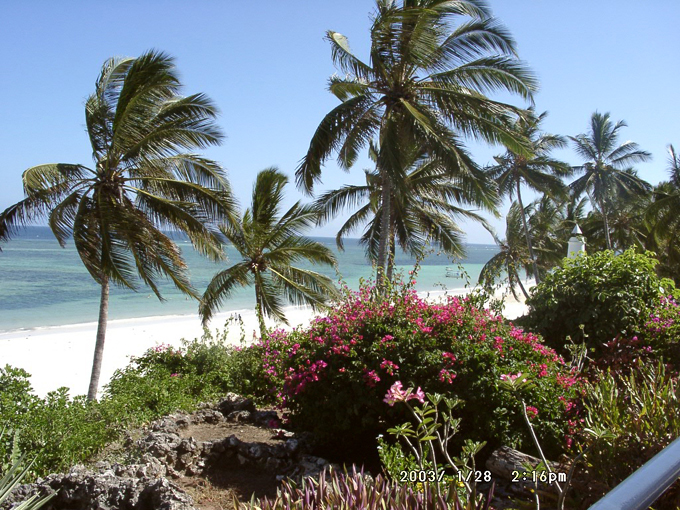
A view onto the Diani Beach from Leisure Lodge Hotel Restaurant
During
our
vacations at Leisure Lodge in January 2002 Ljiljana met a gardener aka “shamba boy” named Nicolas. Unfortunately Nicolas
lost his right
eyesight after an infection at an age of 4-year. He could not’t any
better
job in spite
of his fluent German and English he learned in a
In
January 2003
our holidaying procedure went on the usual way on visiting Leisure
Lodge again.
Though Ljiljana’s protégé Nicolas wasn't’t working as hotel’s gardener
anymore
but through “bush drums” Nicolas appeared few days after. It was agreed
that
Nicolas would guide Ljiljana on a journey to the Kwale District Eye
Center (KDEC)
by using the “matatu” transportation
service. Matatus are minibuses that
stop at any place
along a
road to pick up passengers but tour along a certain road stretch only.
The matatu’s fares are inexpensive and
natives
mostly use
this way of transportation mainly for short distances. On the agreed
day
Nicolas came to the hotel and accompanied Ljiljana on the trek to KDEC.
This
was the first time Ljiljana traveled by this simple transportation
means. They
had to change several matatus to reach the
Center after an hour ride in heat at last. After
a while Nicolas was directed to the outpatient ambulance for a checkup.
Ljiljana
went to
the Center’s administration to obtain official prospectuses and address
including bank account etc. She met there an elderly German lady who
brought
some 40 spectacles as her donation to the Center. She was in company of
Mr. Salim Rahamtula
who turned out to
be a nephew of our late friends in Bamburi Portland Cement Works.
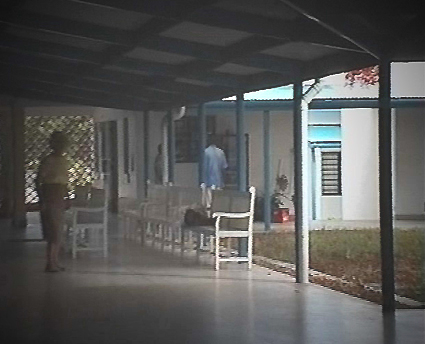
The waiting area in KDEC in one of inner courtyards
When
Salim recognized Ljiljana’s surname he
offered help
as being a member on the Board of KDEC. He introduced both ladies to Dr.
Helen
Roberts,
a British ophthalmologist, who was in charge of KDEC directing it since
its start in 1993. Dr. Helen Roberts was a good looking
and
vigorous lady of early 40s and when learning about Nicolas’ problem
went to see
him in the ambulance soon. Unfortunately for Nicolas his one eye was
lost
for ever. Dr.
Helen suggested place over the eyeball an artificial eye white that
incorporated a
bogus
lens. The artificial eye would make Nicola’s facial
feature look more
pleasant but he would not’t hear of it at first. Then a Kenyan nurse
suggested
Nicolas to take a
mirror to see for himself how a “new eye” would look like on him. She
sneakily
suggesting that he would catch more girls’ attention looking into his
face with
two eyes. Ljiljana offered to pay for Nicolas “new eye” some EUR 8 so
the nurse
showed Nicolas how to he has place in the “new eye”. After instructing
Nicolas
about the necessary care and regular controls she gave also him a
liquid
against eye’s irritation. Obviously Nicolas was too happy with his new
appearance and left KDEC in the best spirit on returning home
alone.
Ljiljana
made a contribution of EUR 30 needed for a cataract surgery to help
another
child
in
need. After several obligatory “kwaheris”
(goodbyes) Salim drove in his car both
visiting
ladies to their
respective hotels on Diani Beach of Mombasa’s
* * * * *
INTERLUDE
Patricia Hughes-Scott wrote in
the
article published in COAST WEEK newspaper, January 09 – 15, 2004 that
worldwide
one person becomes blind every five seconds. Of the estimated 50
million people
completely blind some 90 percent live in countries of the developing
world. In
this article titled KWALE DISTRICT
EYE CENTER - Serving the
Community
with
Affordable Eye Care – she mentions that in Kenya the rate of
blindness
is 10
times that of Europe. In other words in
About a decade ago Dr. Helen
E. Roberts,
a British ophthalmologist, settled with her family at the
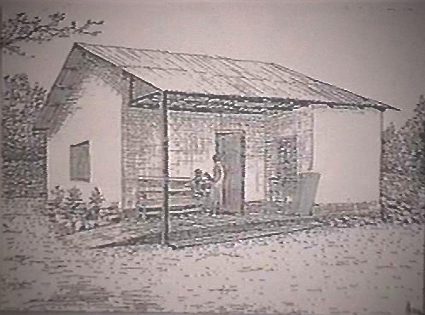
A sketch of the first KDEC building built in 1993
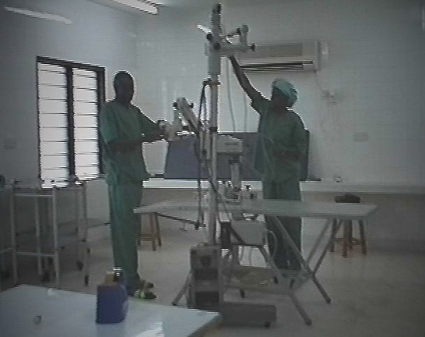
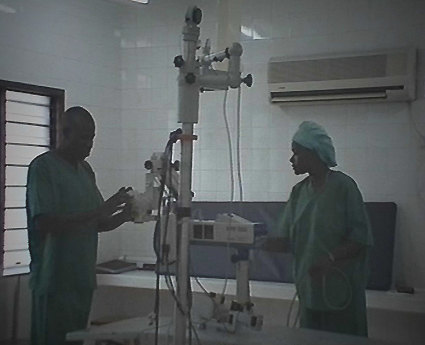
Views in the wide OP-theater of KDEC new compound
KDEC is different from a
regular clinic
as it provides accessible and affordable eye care in the 2nd poorest

From the begin KDEC recruited
Community
Based Workers as trusted and respected persons who were taught to
identify eye
problems and counsel people where to go for treatment. Initially folks
were
afraid through ignorance and did not’t know that cataracts are
treatable but also
afraid that someone would take to their eyes. Village Health Committees
were
formed to identify and address the populace regarding the needless
blindness.
Also KDEC trains District Health Medical Teams and even traditional
birth
attendants are taught to recognize the eye diseases in their working
areas and
to advice individuals on help and curing. According to Dr. Helen it is
the lack
or deficiency of Vitamin A in children’s diet that causes the
blindness. This
happens too often if a child gets an infection like measles and if it
survives
an illness the meager source of Vitamin A in child’s liver is burned
out
followed by the blindness. Cataracts are mostly curable and the only
treatment
is by 20 minute surgery done at the Eye Center. The most rewarding
moment comes
for the surgeon when the eye pad is removed and the patient who could
see
nothing and after less of an hour sees everything. Dr. Helen told about
her
most rewarding moment to be when a child could see a toy in splendid
colors
after all.
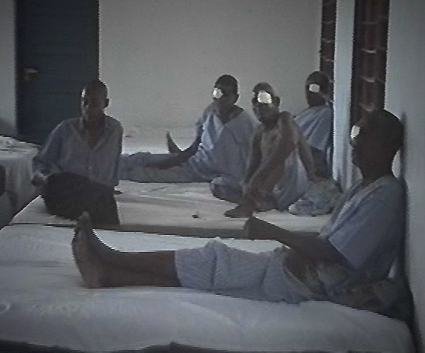
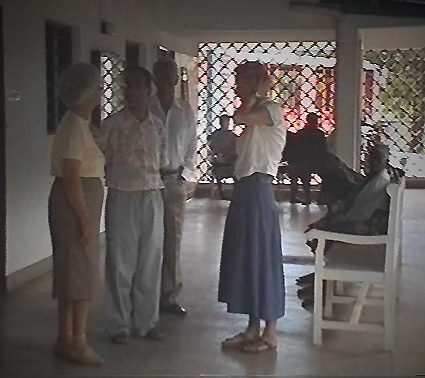
A left males' ward room and visitors talk
to Dr. Helen Roberts at the courtyard
Dr. Helen feels truly humble
and
rewarded when looking on the patient who sees a child’s face for
the first
time or just look at the sky or trees. There was one man who was wanted
to hang
himself because he could not bear his blindness and dependence
on others. After
the treatment he said “You gave me back my life!”. That makes the
Center’s staff feel
really good and proud of their work too. Dr. Helen has many favorite
success stories
but she
likes the one most. There was an old man who was led to the Clinic by a
child
what’s common here. The child becomes the carer for an old person
who
cannot more move around alone. After the operation and when the pad was
removed from old man's eyes he realized soon that he can see again. He
chased the toto
(child) away telling him to go to the school as he was not’t needed
anymore. Dr.
Helen tells on: “He threw his stick in the bushes and we saw him
dancing a jig
outside and in that way he went off down the road he came in blind”.
The KDEC has a partnership
agreement with Christian Blind
* * * * *
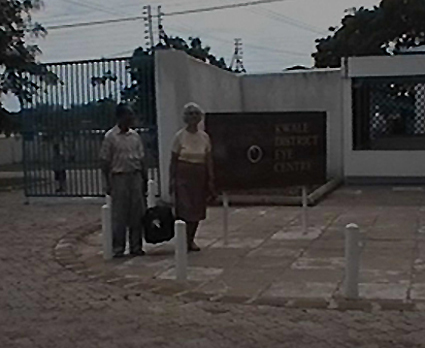
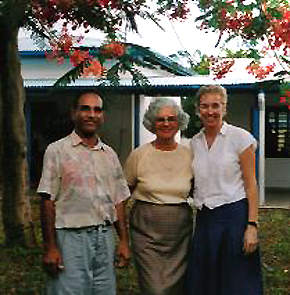
At left Salim and Ljiljana carrying a large bag arrived to KDEC and met Dr. Helen Roberts there
Salim Rahamtula
met
us at the
After
a short
chit-chat our visit had ended when Dr. Helen was called in for another
check of
a private patient waiting on that rather humid afternoon. We have
promised to
come next year “Shauria Mungo”
(God’s Will) and try to make public this extraordinary task started by
a single
but determinate ophthalmologist in this rather poor part of
* * * * * *